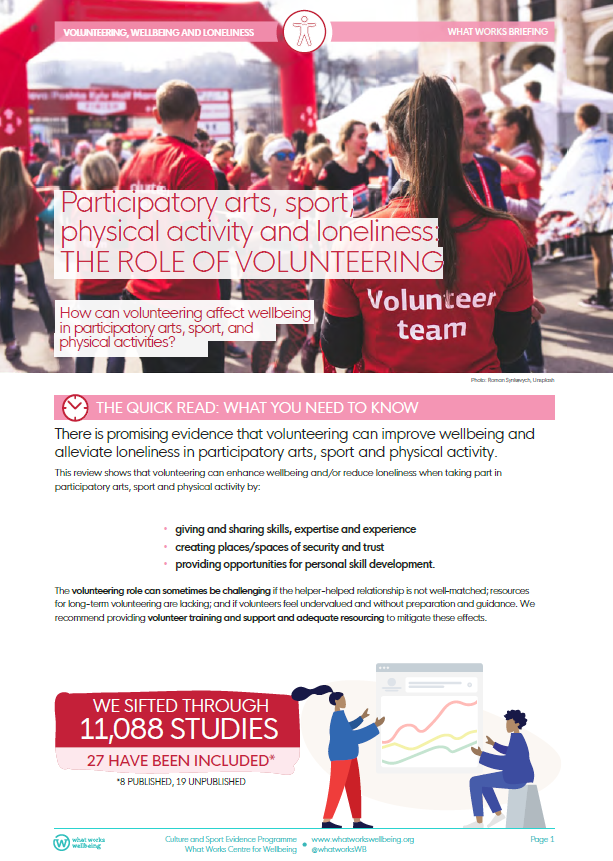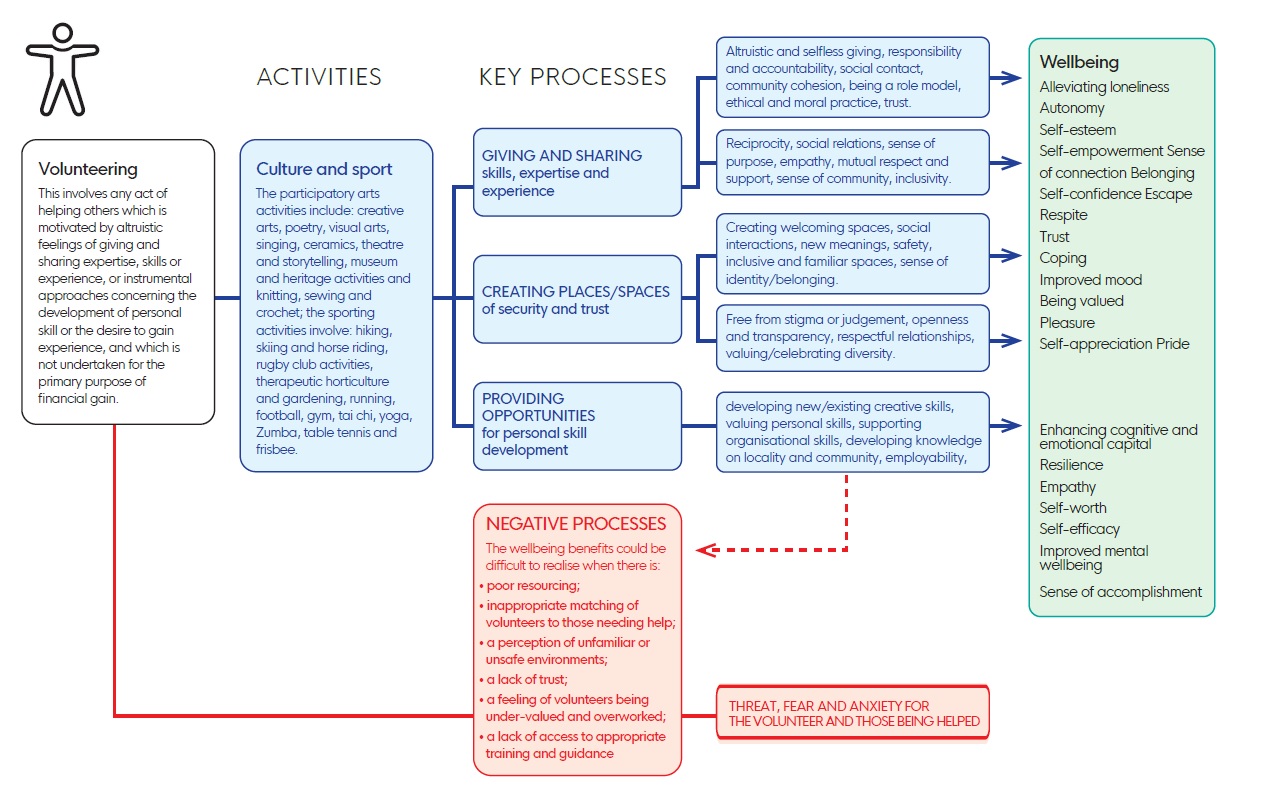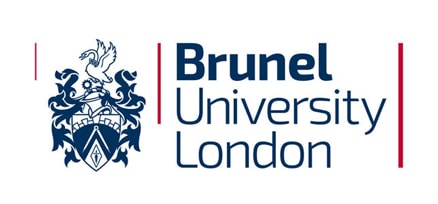Participatory arts, sport, physical activity and loneliness: the role of volunteering
Downloads

The quick read: what you need to know
There is promising evidence that volunteering can improve wellbeing and alleviate loneliness in participatory arts, sport and physical activity.
This review shows that volunteering can enhance wellbeing and/or reduce loneliness when taking part in participatory arts, sport and physical activity by:
- giving and sharing skills, expertise and experience
- creating places/spaces of security and trust
- providing opportunities for personal skill development.
The volunteering role can sometimes be challenging if the helper-helped relationship is not well-matched; resources for long-term volunteering are lacking; and if volunteers feel undervalued and without preparation and guidance. We recommend providing volunteer training and support and adequate resourcing to mitigate these effects.
-
11080
studies sifted through
-
27
have been included (eight published, 19 unpublished)
Process map
The process map below shows how volunteering influences wellbeing and loneliness through participation in cultural and sporting activities.

Definitions explained
Sports/physical activity – Any kind of sport or physical exercise.
Participatory arts – The active participation in any form of creative activity using voice, body or inanimate objects to convey artistic expression
Volunteering – Any act of helping others motivated by altruistic feelings of giving and sharing expertise, skills or experience, or instrumental approaches concerning the development of personal skill or the desire to gain experience. Volunteering is provided for the benefit of others and/or the volunteer and involves activities not undertaken for the primary purpose of financial gain.
The term WELLBEING is used synonymously with a range of concepts in the evidence in this review.
Wellbeing – The positive and/or negative psychological and emotional constructs of wellbeing.
Positive wellbeing is associated with feelings of belonging, empathy, pride and
pleasure, improved self-esteem, self-confidence, self-empowerment and self-worth, a
positive sense of identity, resilience and trust.
Negative wellbeing is connected to feelings of fear, anxiety, discomfort (mental and
physical) and exclusion.
We used the term LONELINESS in this review to examine the connection between wellbeing and loneliness:
Loneliness – The various unpleasant feelings associated with the absence of meaningful
relationships (emotional loneliness), deficits in the quality and quantity of relationships
(social loneliness) and as an expression of separateness from others (existential loneliness).
Solitude – There is also evidence of the positive wellbeing impact of solitude (choosing to be alone) which can be a powerful force for calm and peace: a type of recharging
experience when people need to break from human connection.
What evidence did we find?
Where you see the following symbols it indicates:
-
qualitative
-
quantitative
-
strongWe can be confident that the evidence can be used to inform decisions.
-
promisingWe have moderate confidence. Decision makers may wish to incorporate further information to inform decisions.
-
initialWe have low confidence. Decision makers may wish to incorporate further information to inform decisions.
Participatory arts and sporting activities, included in this review included walking, environmental conservation, rugby club activities and sport coaching, which enabled opportunities for altruistic and selfless giving through the act of volunteering.
The type of volunteering included peer-led activities and acting as a role model and stewardship. These led to positive wellbeing benefits such as a sense of autonomy, self-esteem, empowerment, connection to others and feelings of belonging and community.
There is a potential for trust to be lost when volunteers operate entirely for self-gain. Also, if volunteers felt that their work was not recognised or supported or that their values were not shared, it could lead to burn-out and negative wellbeing experiences.
Mutual (shared) experiences of volunteering, including befriender and peer-led roles, were associated with supporting others, sharing physical and creative experiences and creating a sense of purpose through cultural and sporting activities. Examples in the review included walking groups, horse-riding and skiing, art-making, lunch-cook clubs, creative arts and indigenous sporting competitions. These activities created positive wellbeing experiences of escape and respite, empathy, mutual respect, improving self-esteem, confidence and social ties and alleviating social isolation.
If the volunteering role was fragile in that the helper-helped relationship was not well-matched or the resources for long-term volunteering were not provided, it could hinder the potential wellbeing benefits.
and by enabling people to step into a new space – volunteering created positive wellbeing experiences for helper and helped.
Volunteer roles included in the review were: event organisers, peer navigators and peer-supporters, inside and outside of the home, through participatory arts, sport and physical activities such as World Firefighters’ Games, Park-run, sporting activities and art-making. If the helper-helped relationship was not well matched, it could
lead to feelings of being unsettled.
Participatory arts and sporting activities, including heritage settings, peer-led walking, gardening and land management and Parkrun, through the act of volunteering, led to the creation of secure places/spaces that are free from stigma or judgement by being open and transparent, inclusive and accepting and by enabling mutual support.
They created positive wellbeing experiences such as feeling more resilient, self-confident, autonomous and able to cope with life and where respectful relationships could be developed.
Developing or applying existing creative, organisational, social and leadership skills, knowledge about locality and community and supporting employability was central to the act of volunteering. Taking part in participatory arts, sport and physical activities such as art-making, crafting, creative skills, nature-based and environmental projects and sports-club activities were linked to positive wellbeing benefits including: increased
positive sense of confidence, self-worth, self-esteem, self-efficacy, resilience and accomplishment, thus alleviating feelings of isolation.
There was the potential for some volunteers to feel excluded, lose confidence or feel left behind if they did not feel they possessed the right skills. There is also the need to engage diverse groups of volunteers and to offer ongoing training, awards and qualifications to improve volunteer engagement.
Evidence into action
1. Volunteering has an important role to play in culture and sport policy
and practice
Collaborative partnerships and activities that amplify inclusivity and relationship building, and which serve to:
- share organisational burdens
- identification and delivery of more explicit forms of volunteer training and support
- identification and implementation of the structures of resources and supervision for volunteers that can continue after a volunteering opportunity has ended.
2. Develop collaborative partnerships, volunteer training; and adequate resourcing
The evidence shows that negative wellbeing experiences are possible for volunteers due to a lack of support and training, heavy workloads and feelings of exclusion, and for those being helped if they feel the volunteers are strangers.
These can be mitigated by creating collaborative partnerships and activities that:
- amplify inclusivity and relationship building
- deliver transparent forms of volunteer training and support
- identify and implement the necessary structures of resources for volunteers that can continue after a volunteering opportunity has ended.
3. Offer volunteering that reflects diversity and develops inclusivity
There is a dearth of evidence on volunteering and Black and minority ethnicity populations. Opportunities could be developed by exploring the barriers to including those from Black, minority ethnicity, and socioeconomically deprived backgrounds and by providing incentives, such as awards, qualifications and training.
![]()
[gravityform id=1 title=true description=true ajax=true tabindex=49]


